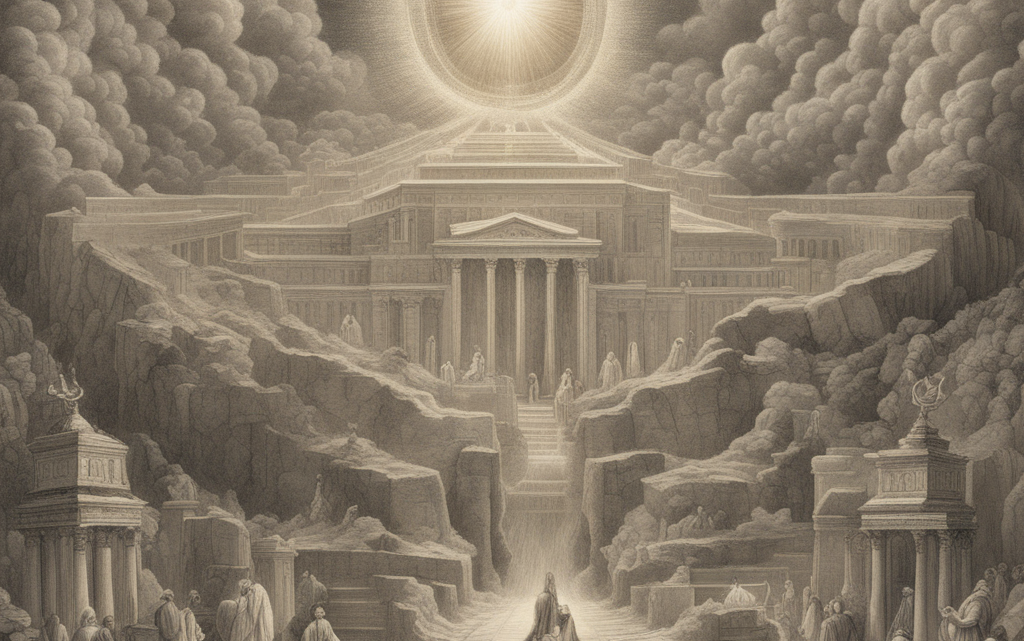The Resplendent Glory of Yehovah and the Deep Symbolism of the Scapegoat Ritual


In the spiritual narrative of the Hebrew scriptures, the glory of Yehovah stands as an emblem of divine presence, a celestial phenomenon depicting the almighty’s deep connection and guidance to His chosen people. This glory, often witnessed as Shekinah, a divine illumination, resonates profoundly, guiding us through eras of spiritual epitomes and declines. Let us venture into the depths of the scriptures, weaving through the landscapes of Yehovah’s glory and the intricate symbolism depicted through the scapegoat ritual during the time of the Second Temple.
Yehovah’s Glory: The Shekinah
The glory of Yehovah, often referred to as the Shekinah glory, symbolizes the visible manifestation of Yehovah’s presence. It is depicted as a heavenly light, a divine illumination that filled the tabernacle and later the First Temple, signifying Yehovah’s approval and His abode amongst His people. This divine phenomenon is described in several scriptures, including Exodus 40:34-35, where Moses could not enter the Tent of Meeting because the cloud had settled upon it, and the glory of Yehovah filled the tabernacle.
The First Temple: A Resplendent Abode
In Solomon’s Temple, the First Temple, this glory was vividly seen, filling the inner sanctuary, the Holy of Holies, a divine assertion of His presence and an emblem of the spiritual pinnacle that Israel had attained through obedience and reverence to Yehovah’s commandments (1 Kings 8:10-11).
A Departure Marked with Sorrow
Sadly, as we traverse the scriptural narratives, we witness a time of spiritual decline, where the Israelites drifted away from the divine path laid by Yehovah. This drifting away is vividly captured in Ezekiel’s visions, where he witnesses the gradual departure of Yehovah’s glory, a retreat from the cherubim to the threshold of the temple, and finally standing aloof on the Mount of Olives, signifying a painful but necessary distance due to the disobedience and wayward paths taken by His people (Ezekiel 10:18, 11:23).
The Second Temple: An Awaited Return
As we step into the era of the Second Temple, built post the Babylonian exile, a sense of anticipation fills the air, a longing for the return of Yehovah’s Shekinah glory. Yet, the scriptures do not record a return as grand and magnificent as it was during the time of Solomon. This unfulfilled return leaves a spiritual void, a longing for a more profound connection, a deeper union with the divine.
The Scapegoat Ritual: A Symbol of Atonement
In the midst of this deep spiritual yearning, the tradition of Yom Kippur, the Day of Atonement, carried a significant ritual that stood as a sign of Yehovah’s presence and the cleansing of the sins of the people. The scapegoat ritual, deeply ingrained in the traditions of Yom Kippur, involved two goats – one to be sacrificed to Yehovah and the other, the scapegoat, to carry away the sins of the nation into the wilderness.
The High Priest would place his hands on the scapegoat, confessing the sins of the Israelites, symbolically transferring their iniquities onto the goat. This scapegoat, laden with the sins of the people, would then be led away into the wilderness, a vivid depiction of taking away the sins, purifying the nation, and being graced with Yehovah’s forgiveness (Leviticus 16:21-22).
A Ribbon Bearing Witness to Atonement
In the traditions chronicled in the Talmud, a further element embellished this ritual – a crimson ribbon tied to the door of the temple, an element that carried deep symbolism. As per the tradition, this ribbon would miraculously turn white, signifying Yehovah’s acceptance of the sacrifice and the atonement of the nation’s sins, a divine gesture of forgiveness and cleansing.
The Cease of the Miracle: A Divine Message?
However, this tradition carries a solemn note, a detail that invites deep reflection. The Talmud records that forty years before the destruction of the Second Temple, this miracle ceased to occur. The crimson ribbon no longer turned white, a sign that seemed to echo a divine dissatisfaction, a loss of connection that once was vibrant and alive.
As we stand at this juncture in the narrative, we are led to ponder deeply on the implications of this cessation. Could this be seen as a divine message, a proclamation of a new era ushered through the crucifixion of Yeshua? Yeshua, during his time, spoke of a renewed covenant, a new pathway to experiencing Yehovah’s glory, not confined to a temple but a glory that could dwell within each believer, transforming hearts and guiding souls to a deeper union with Yehovah.
A New Understanding of the Divine Glory
As we retrospect on the teachings of Yeshua, we see a beckoning towards a new understanding of Yehovah’s glory, a call to witness the divine presence not in a physical structure but in the embodiment of love, grace, and truth that Yeshua depicted. Yeshua spoke of His body as a temple (John 2:19-21), a vivid representation of a living temple, one that carried the essence of Yehovah’s teachings and glory.
Conclusion: A Beckoning to Rekindle the Divine Connection
As we traverse this detailed journey through epochs of spiritual highs and lows, the glory of Yehovah remains a central theme, guiding us to understand the deep love and connection Yehovah desires with His people. The cessation of the ribbon’s miracle beckons us to rekindle this divine connection, to step into a new understanding of Yehovah’s presence, an understanding grounded in love, obedience, and a personal, profound relationship with Yehovah.
As we stand in this era, let us be guided by the scriptures, embracing a path of righteousness and seeking a deeper connection with Yehovah, cherishing the divine presence that seeks to dwell within each one of us, guiding us to a life of fulfillment, grounded in Yehovah’s eternal love and grace.

